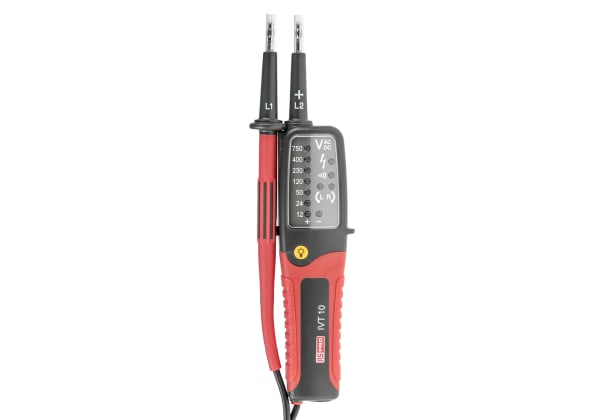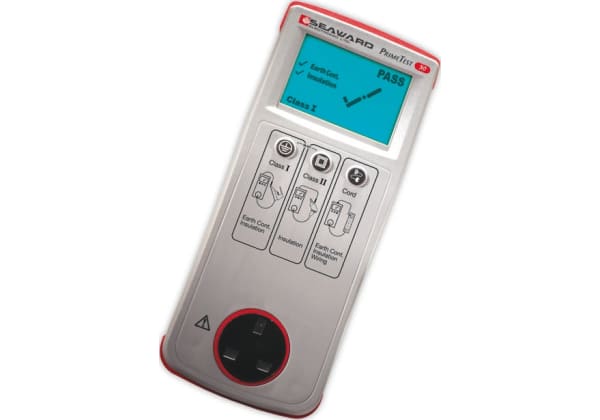- Published 9 Aug 2023
- Last Modified 9 Jan 2024
- 6 min
What is the Best Multifunction Tester?
Explore multifunction testers for a range of electrical measurements and safety tests. Consider key specifications and features to find the right tester for your requirements.

Reviewed by Peter Kendall, Technical Support Engineer (December 2023)
Multi functional tester / MFTs and electrical testers are essential tools for electricians, allowing them to work effectively and efficiently. Electricians use MFTs for electrical test and measurement to see if electrical installations are functioning correctly and safely. Types of tests carried out by multifunction testers include loop, residual circuit device, earth resistance, phase sequence testing and continuity. There is also other electrical test equipment available that carries out basic tasks such as measuring voltage.
There are a lot of MFTs on the market, so the choice can be daunting. It’s key to make sure you buy the right tester for your specific needs. At RS, we supply engineers across the world with quality, reliable equipment. Our in-depth guide will help you consider all the key features and find the best electric tester or multifunction electrical tester for your needs.
The first thing you need to be aware of is electrical safety standards. BS7671 is the British standard used since 1992 for electrical installation and safety in domestic, commercial, and industrial properties. 7 tests are included in BS7671, but most installations only require 5. Selecting the ideal multifunction testing equipment depends on the type of work you perform. MFTs fall into three categories:
- Domestic.
- Commercial – working at higher voltages with more extensive residual circuit device testing.
- Industrial – additional testing capabilities for industrial applications, e.g. medical equipment.
It’s important to understand the range of multifunction and basic electrical test equipment available. It includes these types of tester:
Electrical Safety Tester
Electrical safety testers can perform a range of measurements including:
- Insulation resistance.
- AC and DC dielectric strength.
- Grounding systems resistance.
- Outlet polarity.
- Earth continuity.
- Line leakage.
- RCD trip testing.
Electrical Circuit Tester
An electrical circuit tester plugs into a wall to show if the power supply is delivering AC power. Circuit testers are quicker and easier to use than multimeters for basic tests like this.
Electrical Voltage Tester
A simple electrical voltage tester measures AC or DC voltage and continuity. Small, lightweight, and inexpensive, voltage testers are an excellent option if you don’t need a wide variety of functions.
How to Use a Multifunction Tester
You should always know how to use the multifunction tester for the procedure you are performing. Check the manual to make sure you know the specifications of your device. Multifunction testers should only be employed by electricians or technicians who have been trained in their use. Risk assessments of the electrical work to be carried out should also be undertaken prior to starting the job.
It’s also important to calibrate your tester. Correctly calibrated MFTs (ideally calibrated by an accredited external lab) give readings that are accurate, which helps to avoid making errors.
Using a multifunction tester enables an electrician to check the safety of circuits in commercial and industrial settings, ensuring that wiring meets safety standards and has been correctly fitted.
When working on electrical equipment, safety is the number one priority. When testing is taking place, the circuit or equipment should be dead. If it is essential that the system is live, all work should be carried out in compliance with HSE guidelines and using suitable PPE as necessary.
If the work is taking place in a manufacturing facility or there are a lot of people present, lockout / tagout procedures should be followed to isolate electrical equipment and ensure it is not re-energised accidentally.
Use your multifunction tester for:
- Continuity tests. (Check for breakdowns in insulation.)
- Earth fault loop impedance. (Test a circuit’s ability to use circuit breakers and fuses.)
- Insulation resistance tests.
- Residual circuit device (RCD) tests.
- Portable appliance testing (PAT testing).
- Testing electric vehicle charging points.
- Short circuit current tests.
The RS range of multifunction electrical testers is designed to handle life on the job. It features durable, accurate equipment that you can rely on day after day. We also stock essential accessories for your multifunction tester including mains test leads, adapters, and storage cases to ensure you’re equipped for every eventuality.
How to Test Electrical Current with a Voltage Tester
Non-contact voltage testers are basic devices that reveal the presence of electrical voltage. Voltage testers differ from multimeters in that they only detect the presence of voltage as opposed to conducting a number of different measurements. The principle voltage testers are based on is Ohm’s Law.
Ohm’s Law states that the electric current through a conductor between two points is directly proportional to the voltage across the two points. Voltage tester design includes non-contact types that detect voltage through insulation. Voltage testers are typically encased in non-conductive materials. This ensures the user is protected from electric shock.
So how do voltage testers test electrical current? The technician touches the tip of the tester to the wire or electrical outlet. The voltage tester tests a small amount of current from the circuit using sensors that detect the presence of voltage. Some units make sounds or flash to indicate voltage is present. Other more sophisticated systems may provide a value for voltage. Current travels through a known resistance within the voltage tester and the drop-off in voltage is then displayed on screen so the engineer can see the voltage present in the circuit. The tester should show if there are adequate levels of voltage in the circuit under test. If not, it may indicate there is a fault.
How to Calibrate a Multifunction Tester
Multifunction testers are safety-critical devices so their calibration is important and should be carried out by specialist external labs. Multifunction tester calibration can help ensure that the multifunction tester is working according to the specifications of the manufacturer. It should be carried out at regular intervals; typically annually, but the more often, the better – especially if the equipment is being frequently used.
You may want to use a state-of-the-art UKAS calibration service to calibrate your multifunction tester. UKAS calibration takes place in a facility that has been independently audited as suitable for the work. UKAS is the only organisation recognised by the government in the UK for accrediting the competence of multifunction test laboratories.
Multifunction testers are versatile tools that allow an electrician to carry out a wide range of crucial testing activities without having to switch between a lot of different pieces of equipment, which makes them very efficient. There are a lot of different MFT systems on the market, varying widely in price. Think about your investment long-term and the functionality that you need for your electrical testing requirements when you buy.
Did you know RS offers an accredited UKAS calibration service for multifunction testers? Learn more about our service here.
Related Guides
Related links
- Martindale ET5 Multifunction Tester, RS Calibration
- Martindale ET4 Multifunction Tester, RS Calibration
- Fluke T5 Multifunction Tester, RS Calibration
- Megger MET1000 Multifunction Tester, RS Calibration
- Fluke T5 600 Multifunction Tester, RS Calibration
- Gossen Metrawatt Master Package TECH+ IQ Multifunction Tester
- Extech DO600 Multifunction Tester
- Martindale ET5 Multifunction Tester


